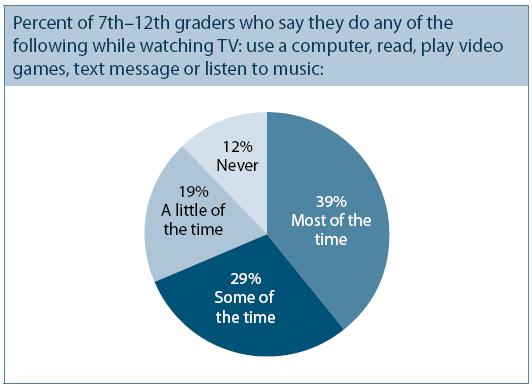Kids Are Watching More TV

WASHINGTON: Kids and teen-agers manage to squeeze nearly 11 hours of media time into seven-and-a-half, thanks to multitasking, the Kaiser Family Foundation says. They’re also watching more TV than they were five years ago, just not as much of it on a traditional television set. Kaiser looked at around 2,000 youngsters aged eight to 18 between October of 2008 and May, 2009. The group watched two hours and 39 minutes of live TV per day compared to more than three hours in 2004. However, total TV consumption was 4:29, compared to 3:51 five years earlier. The disparity is attributed to the growth of distribution platforms. Kids watched nearly an hour of TV content on computers, iPods and MP3 players, and cell phones--platforms that weren’t measured in 2004.
“Watching TV on new platforms has become fairly routine among young people,” the Kaiser study said. “Almost half of all 8- to 18-year-olds say they have ever watched TV online, and 30 percent report having watched TV on a cell phone, iPod, or other MP3 player. In a typical day, half will view some TV content on at least one of those new platforms. In fact, television watching among young people today is split about 60/40 between live TV on a TV set, and other types of viewing--59 percent, or 2:39, live TV; and 41 percent, or 1:50, that is viewed on demand, online or on DVDs, DVRs, or mobile devices.”
Kids manage to pack more media consumption into the day by using multiple devices simultaneously. Kaiser said that even as kids watch TV, they’re likely to be texting or Instant Messaging. Among seventh to 12th grades, 47 percent said they typically texted friends about what they were watching. Twenty-two percent said they did the same thing via IM.
Among all the video media platforms, TV was the one kids spent the most time with. Most in the survey said parents were more likely to set rules about what they could watch rather than how much. Some 46 percent said they had content rules, while just 28 percent said they had time limits in front of the tube. Around 45 percent said they lived in a home where the TV is on all of the time, whether someone’s watching or not.
(Image by palmasco)

The professional video industry's #1 source for news, trends and product and tech information. Sign up below.
